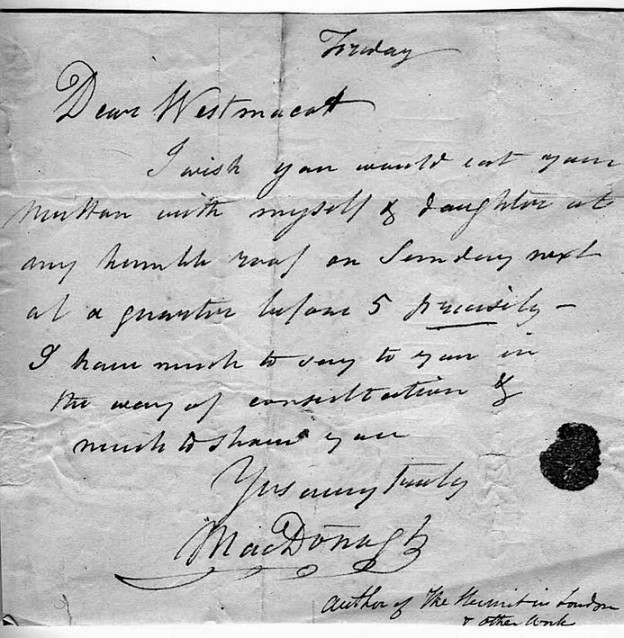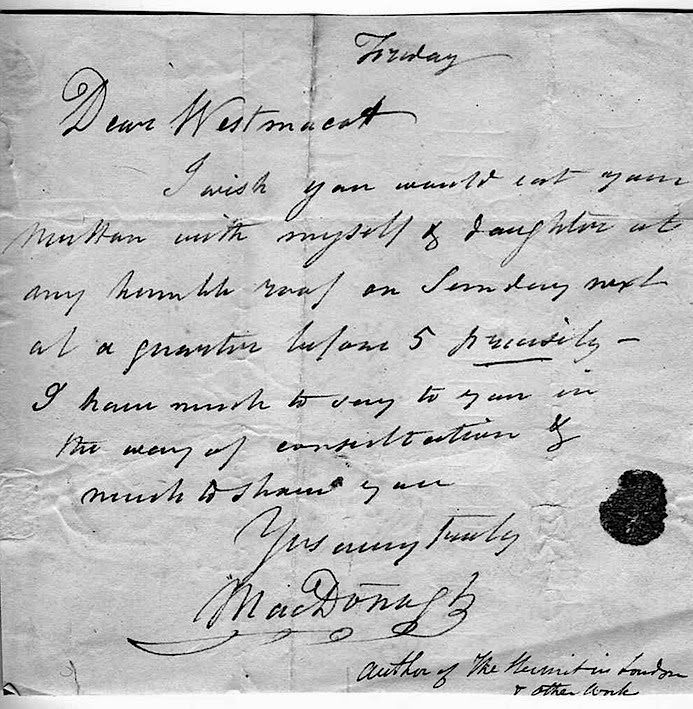This scrap of a letter, on paper watermarked 1824, was discovered a few years ago in a pile of autographs. It had been sent by the rather obscure W.B.MacDonagh, author of The Hermit in London to Charles Molloy Westmacott, editor of the notorious Age newspaper, and author of the London Spy, and proposed a meeting to discuss business.
What little we know about Macdonagh suggests that he was a harmless hack who, like Westmacott himself, was familiar with the fashionable world of Pierce Egan’s Regency flaneurs Tom and Jerry and Corinthian Tom, the prize-fighting coteries of ‘The Fancy ‘and the dandies of the Burlington Arcade. Westmacott, however, was a very significant figure in the Regency smart-set, in that through his blackmailing activities as editor of The Age he became one of the most hated men in England.
Westmacott’s methods were simple enough. He let it be known that he was in the market for compromising letters that would, if exposed to the public gaze, ruin the reputations of the highest placed in polite society. Access to such material was not a problem for Westmacott. There were plenty of aggrieved employees willing to sell on stolen letters and the editor was not stingy in his payments. It was then simply a matter of letting those compromised parties know that public exposure in his newspaper would follow if payment for the restoration of the letters was not forthcoming. Westmacott was naturally aware that such conduct involved a risk to his own life, and indeed we know that a particularly painful revenge was meted out to him on one occasion, when he was ambushed in his own office by an aggrieved victim, who proceeded to administer a sound horsewhipping. Probably recognising that worse might follow if he continued on his present course, Westmacott retired from public life not too long afterwards. Many years later, at his death, much unsold compromising material was discovered among his papers.
If all this sounds familiar to fans of Sherlock Holmes, then it is because there is strong, albeit circumstantial evidence, that Arthur Conan Doyle based his portrait, at least in part, of the murdered blackmailer Charles Augustus Milverton, on Westmacott. Back in the early 1980s I published an article in the Sherlock Holmes Journal arguing the case. Although another candidate, closer in time to the stories, has also been proposed as the model, I stand by my theory.
To return to the letter from MacDonagh. It is tantalising to speculate that the meeting proposed by the latter between himself and Westmacott was an opportunity to discuss some shady ‘ business’. In the words of Macdonagh:
‘ I have much to say to you in the way of consultation and much to show you ‘.
[RMH]


